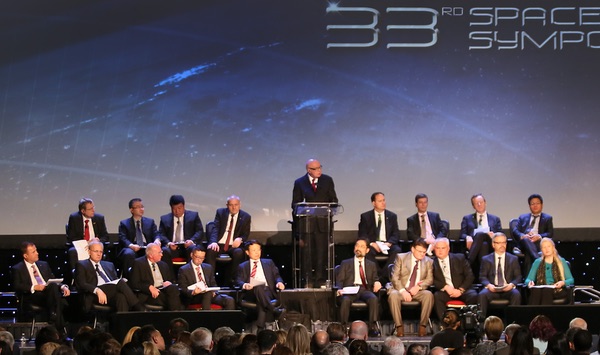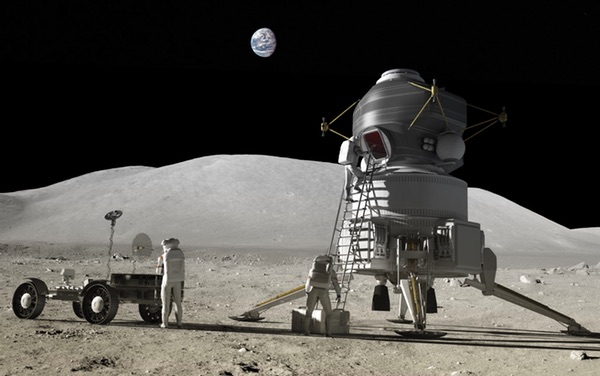International and commercial interest in the Moonby Jeff Foust
|
| “The goal here is to see what we can prove out in the area around the Moon [and] work with our international partners on what we do at the surface of the Moon,” Lightfoot said of NASA’s cislunar outpost plans. |
However, other space agencies remain interested in sending spacecraft, and perhaps people, to the Moon in the coming years. That interest was on display earlier this month at the 33rd Space Symposium in Colorado Springs, Colorado, an event that has increasingly taken on an international flavor, including dropping “National” from its name a few years ago.
But sometimes it can seem too international. A panel session at the conference April 4 featured leaders from a number of national space agencies. That number has been growing over the years, and this year it meant 15 space agency heads took to the stage in the main convention hall at the Broadmoor, from major agencies like NASA, ESA, and Roscosmos to smaller national agencies from Romania and Vietnam. The panel was so big that the agency leaders were arranged in two rows on the stage: a choir preaching a gospel of cooperation and collaboration to the conference attendees.
The panel was so large that, rather than give the same question to all speakers, moderator Bob Walker instead directed questions to various subsets of the full panel. To one subset he posed the question: what are your aspirations for the exploration of the Moon?
One of the panelists for that question, as it turned out, was Robert Lightfoot, acting administrator of NASA. He mentioned the agency’s plans to, in the 2020s, develop a “Deep Space Gateway” in cislunar space (see “A gateway to Mars, or the Moon?”, The Space Review, March 27, 2017). That gateway is intended to prepare for human missions to Mars, but he left open the option of using it for human missions to the Moon as well by partners.
“The goal here is to see what we can prove out in the area around the Moon, work with our international partners on what we do at the surface of the Moon, and work with our public-private partnerships here in the US to understand the niche areas they would like to attack when it comes to the Moon,” he said.
Ger Nieuwpoort, director of the Netherlands Space Office, said his country’s plans for the Moon were tied to those of the European Space Agency, with a particular interest in science applications. “Science is an important driver for the Netherlands,” he said. That included, he said, the prospects for doing astronomy from the far side of the Moon.
| “It’s not just humans. Moon Village means robotic and human activities, private and public entities. Like a village on Earth, where different people are coming together to do something jointly, this is the Moon Village,” Wörner said. |
By contrast, Roberto Battiston, president of the Italian Space Agency and another member of ESA, took less of an interest in the Moon except as a way to support human missions to Mars. “The Moon can be very useful as an intermediate step to learn how to stay for long periods in space,” he said. “But the real future goal, for the long term, is really getting to the next challenge, which is Mars.”
While he wasn’t on the panel that got the question about lunar exploration, ESA director general Jan Wörner did put in a plug later in the session for his “Moon Village” concept of an international lunar base, which he said was essential before humans could go to Mars.
“We think that the Moon is a very important step. Mars is not the ultimate goal; humans will go further than Mars,” he said. The Moon, he added, offered “special opportunities” for developing new technologies, including the production and assembly of hardware as well as a source of resources.
“As some of you might know, I’m promoting the idea of international cooperation on the Moon. I call it ‘Moon Village’ with some misunderstandings,” he said. “It’s not just humans. Moon Village means robotic and human activities, private and public entities. Like a village on Earth, where different people are coming together to do something jointly, this is the Moon Village.”
“The Moon Village,” he added, “is part of our overall strategy: LEO, Moon, Mars.”
 A panel of space agency leaders at the 33rd Space Symposium April 4 was so large it required two rows on the conference stage. (credit: space Symposium) |
One country that might be interested in ESA’s Moon Village is China. Yulong Tian, secretary general of the China National Space Administration, outlined his country’s plans for robotic exploration of the Moon, including the Chang’e-5 sample return mission scheduled for launch late this year.
Future missions, he suggested, could include landers to the lunar poles to prospect for resources there to support human bases. “In the coming five to ten years we have a few more missions to the polar regions of the moon, including establishment of a lunar base, or part of the Moon Village,” he said.
Igor Komarov, director general of the Russian state space corporation Roscosmos, also supported human missions to the Moon before going to Mars. “We should go to the Moon,” he said at a press conference later the same day, in part to study issues associated with Mars missions. “It’s better to solve all these problems on the Moon before going to Mars.”
If at least some countries are on board, what about companies? At a press briefing at the conference April 3, Boeing provided an update to its “Path to Mars” architecture, which also calls for the development of an outpost in cislunar space. That concept looks very similar to NASA plans recently rolled out, and Boeing executives even called it the Deep Space Gateway, like NASA.
One difference, though, was that the Boeing plans included the option of adding a lunar lander to the habitat, power, and other modules that comprise the outpost. Boeing officials didn’t play up the inclusion of the module, which was included in handouts at the press conference that outlined the development of the gateway.
“The idea it to put enough infrastructure around the Moon that allows us to do two things,” said Peter McGrath, global sales and marketing director for space exploration at Boeing. “It allows either other governments, our government, or a commercial entity to go to the surface of the Moon, but it also serves as a staging point for our future exploration missions to Mars.”
Immediately after the heads-of-agencies session at Space Symposium, United Launch Alliance hosted a session to discuss its “Cislunar 1000” vision, the company’s 30-year plan that foresees 1,000 people living and working in cislunar space, including the Moon.
“As NASA and other people push deeper into deep space to explore, we want to develop the space between here and the Moon, and a self-sustaining economy will make that presence stick,” said Tory Bruno, president and CEO of ULA. “People will go to space because there are jobs in space. They will live there because they will have a better life there.”
Neither Bruno nor the panelists, who represented companies, organizations, and even the US Air Force, offered much in the way of updates for the Cislunar 1000 vision. Bruno said he sees ULA as “just the railroad” enabling the creation of that cislunar economy, one that will require a lot of companies.
| “People will go to space because there are jobs in space. They will live there because they will have a better life there,” Bruno said. |
Who those companies are remains to be seen. “There are three interesting threads that make our time special,” said Jim Keravala of Offworld, a company developing mining robots for use on the Earth and, eventually, the Moon. Those threads include a convergence of various technological trends, a “glut” of investment capital ready to invest in these efforts, and the development of customers.
“We are still not at a point in time where a single company or organization can create and close the chain from product development and service to end user development in space beyond GEO,” he said. Cislunar 1000, he said, creates an opportunity to bring together a “community of service providers and entrepreneurs” to create that end-to-end marketplace.
Andrew Rush, president of Made In Space, the company that has developed 3-D printers for the ISS and other in-space manufacturing technologies, sees the Cislunar 1000 vision as a way to build up demand for its services. “We want to buy a rocket, we want to be an anchor tenant of a commercial habitat, and that’s the next step,” he said. “We are in a unique point in history” in that such a development path is feasible, he said.
How Cislunar 1000 fits into NASA’s plans, through, wasn’t clear from the panel discussion. It’s possible that companies could make use of the Deep Space Gateway to support their plans, but clearly they are not relying on it.
But then, maybe NASA isn’t going back to the Moon after all. As this article was going to press April 24, President Trump spoke to astronauts on the International Space Station, where he appeared to provide a newfound urgency for human missions to Mars. Told by astronaut Peggy Whitson that NASA’s plans for those missions, also mentioned in the NASA authorization act signed into law by Trump last month, called for human missions in the 2030s, he was not satisfied.
“Well, we want to try to do it during my first term or, at worst, during my second term, so we’ll have to speed that up a little bit, okay?” he said. It’s not clear how serious he was, but one thing was clear: there was no mention of humans going back to the Moon during his conversation.
